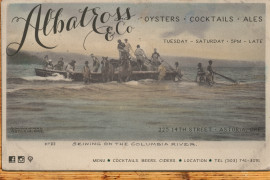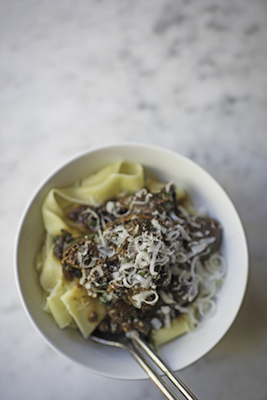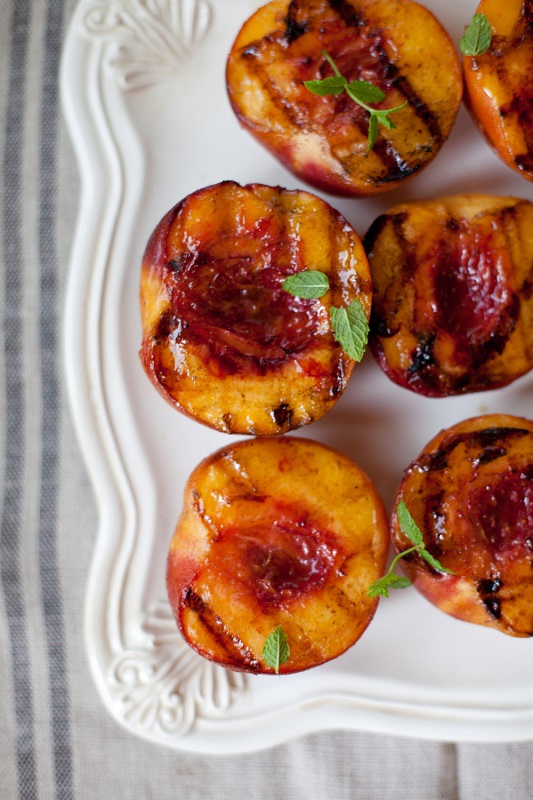As the weather turns colder, Pacific Northwesterners look toward winter—hearty stews and melted sandwiches warm our bellies, washed down with complimentary porters and stouts. These flavor-packed beers are perfect companions for everything the chilly months have to offer. The creativity of Oregon brewers shines as traditional styles, born in England and Ireland, are given a Northwest twist. In a state saturated with pioneering spirit, Oregon’s beers reflect the rich historical heritage of our forebears, as well as the skill and innovation of today’s brewmasters.
As I look forward to pairing beers with homemade beef stroganoff or a rich chocolate pumpkin cake, I start to wonder about the perennial discussion between brewers and beer lovers: What’s the difference between a porter and a stout? If you base your definition on the descriptions written on bottles and brewery websites, the answer is “not much!” Surely there’s some defining point between them I think to myself, and so decide to investigate further.
To begin, we have to understand the ways in which beers derive their color and flavor. Malted barley is the magic ingredient that creates sugars for the yeast to turn into alcohol. Differentiation in the degree to which barley is kilned or roasted gives various color, flavor and depth to beer in the same way a more roasted coffee bean makes a darker cup of joe. Most beers today begin with a pale malt bill as their canvas. Roasted and specialty malts are added in smaller quantities to combine with nuances in water, yeast choices and hops.
Stouts began as a stronger version of the popular 18th century porter (a hoppier, stronger version of brown ale), and were referred to as “stout porters.” It seems the historical departure between porter and stout was a tax-driven development. “Porter” style beer was popular in London in the early 1720s with the city’s river porters—hence the name. These beers differed from other ales, displaying stronger flavors, greater resistance to spoiling and temperature fluctuations, higher alcohol content and moderate price.
When the malt tax was increased to help pay for the Napoleonic War, brewers had incentive to use less malt. The solution? Coloring was added to a pale malt base in order to maintain the expected color. Britain then passed a law in 1816 declaring that only malt and hops could be used in the production of beer. The brewers got creative again with the invention of black “patent” malt, a malt kilned to about 200°C (the point of carbonizing), resulting in a somewhat smoky undertone in flavor, and the desired hue. This made it possible to brew porters using 95% pale malt and 5% black patent malt, preserving the essence of porter-style beer while obeying the taxation and ingredient laws.
The descriptor “stout” was applied to the heftier versions of those porters. Eventually, the additional word porter was dropped—leaving “stout” to emerge as a separate stylistic nomenclature.
Today, the line between the two styles is fuzzy at best—while the general consensus acknowledges that stouts are derived from porters, the practical differences are still open to interpretation. Our best bet in determining whether something is a stout or a porter? Whatever the brewer calls it. As Michael Zarkesh, brewer at Falling Sky in Eugene postulates, “it is primarily the difference between chocolate and roast, both in flavor and ingredients. While these descriptors are not mutually exclusive, it does matter which flavor is dominant and which complementary. Basically, a porter should be more ‘chocolate focused’ with roast complimenting, and a stout should be ‘roast focused’ with chocolate complimenting.”
Rob Widmer of Widmer Brothers agrees, adding “I think that there is quite a bit of overlap between these two styles and, craft brewers being craft brewers, some completely ignore this rule of thumb.”
Historical accuracy and flavor profiles aside, there are plenty of opportunities to enjoy these beers. Whatever your pleasure, porters abound. There is even an entire festival dedicated to stouts! The Festival of the Dark Arts, held annually at Fort George Brewery in Astoria, brings together dozens of stouts, fire dancers, belly dancers, blacksmithing demonstrations, tattoo artists, tarot card readings, live music, wet plate photography and a cigar tent. Coming Saturday, February 15th, the event is free (purchase of a mug and tokens are required for tastings). Complete details are available at fortgeorgebrewery.com.
Whatever the moniker, there’s no denying these flavor packed beers are a perennial favorite across our state. Try them with rich meats such as roasted pork and beef, as a complement to chocolate- and coffee-based desserts, and as a foil to blue cheese or extra sharp cheddar. Celebrate the seasonal abundance with the following beers:
Porters:
Fort George Brewery | Working Girl Porter | 4.75% ABV
Well balanced with chocolate & rye malts
Falling Sky Brewing | Kama Sumatra Coffee Porter | 5% ABV
Made with custom-roasted Sumatra & Guatemalan coffee from Global Delights in Eugene
Mazama Brewing | Pyroclastic Porter | 5.2% ABV
Coffee, dark chocolate & caramel
Deschutes Brewery | Black Butte Porter | 5.2% ABV
Prizewinning, classic Northwest porter
Calapooia Brewing Co. | ‘Pooya Porter | 5.5% ABV
Dark, robust with mocha finish
Widmer Brothers Brewing | Steel Bridge Porter | 5.6% ABV
Oregon Brew Crew Collaboration: mocha, chocolate & toffee flavors
Coalition Brewing Co. | Loving Cup Maple Porter | 5.8% ABV
Seven grain with Vermont Grade A Maple Syrup
Laurelwood Brewery | Organic Tree Hugger Porter | 5.8% ABV
Brewed with 100% organically grown malt
Hop Valley Brewing Company | Vanilla Infused Porter | 5.9% ABV
Conditioned with fresh organic vanilla beans
BricktownE Brewing Company | Whiskey Canyon Porter | 6.8% ABV
A mild chocolate porter aged with French oak soaked in Pendleton Whiskey
The Prodigal Son Brewery | Bruce/Lee Porter | 7.8% ABV
Rich chocolate with a strong coffee flavor
Lompoc Brewing | Monster Mash Imperial Porter | 8.1% ABV
Malty sweetness balanced with bitter notes of dark chocolate, coffee & hops
Deschutes Brewery | Class of ‘88 Imperial Smoked Porter | 9% ABV
Limited-run collaboration with Great Lakes Brewing; subtle smoke with rich chocolate
Mazama Brewing | Bourbon Baltic | 9.1% ABV
Fermented and aged in oak bourbon barrels
Stouts:
Breakside Brewery | Dry/Irish Stout | 4.7% ABV
Award-winning, classic demonstration of an Irish-style stout
Lompoc Brewing | Stout Out Loud | 4.9% ABV
Coffee, chocolate and raisins are balanced by acidic dark malts
Pints Brewing | Steel Bridge Stout | 5.2% ABV
Rich and chewy; loaded with espresso, coffee and rich malt flavors
The Prodigal Son Brewery | Fatted Calf Sacrificial Stout | 5.6% ABV
Rolled oats and soft wheat with chocolate malts
Oakshire Brewing | Overcast Espresso Stout | 5.8% ABV
Silky oatmeal stout, smooth and full of rich coffee flavor and aroma
Three Creeks Brewery | FivePine Chocolate Porter | 6% ABV
Brewed with twenty pounds of Belgian cacao nibs
Laurelwood Brewery | Organic Portland Roast Espresso Stout | 6.3% ABV
Collaboration with Portland Roasting Company; rich espresso flavors with chocolate notes
Calapooia Brewing Company | Devil’s Hole Stout | 6.5% ABV
Hints of licorice, coffee, chocolate, oak and vanilla
Sasquatch Brewing Company | Hairy Knuckle Stout | 6.9% ABV
Coffee and oatmeal tones in classic American Stout
BricktownE Brewing Company | Rock Steady Stout | 7% ABV
Wheat based, served on Nitro
BaseCamp | S’more Stout | 7.7% ABV
Roast chocolate and fig with a touch of graham cracker; served with a toasted marshmallow
Fort George Brewery | Cavatica Stout | 8.8% ABV
Immense, bold and black as night
Fort George Brewery | Rye Whiskey Cavatica Stout | 9.2% ABV
Barrel aged on Heavens Hills rye whiskey barrels
Calapooia Brewing Company | Undertow Imperial Stout | 9.5% ABV
Over 1000 pounds of malt per 7.5 barrel batch
* For an even deeper twist on stylistic fluidity, try a taste test with beers from the list above, adding Full Sail’s Limited Lager Series Black Bock to the lineup. Coming in at a smooth 7% ABV, this beer is a completely different animal than a porter or stout, but surprisingly similar flavors of chocolate and espresso come shining through.

Emily Engdahl is the founder of Oregon Beer Country, a travel and tourism site dedicated to all things beer in Oregon. Emily is a freelance writer for 1859, Travel Oregon, the Oregon Beer Growler, and craftbeer.com. She is a Native Oregonian, graphic designer, homebrewer, beer drinker, coffee roaster, joker, instigator, helper, laugher, listener, voracious reader, chicken keeper, and dog and kid wrangler. Basically, a many hats wearer.







